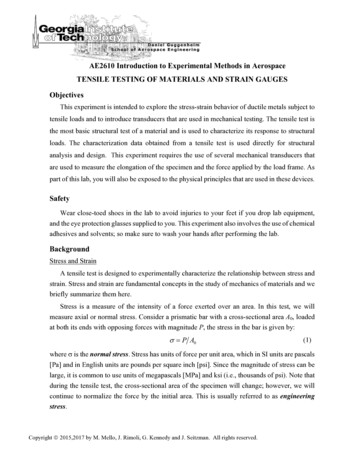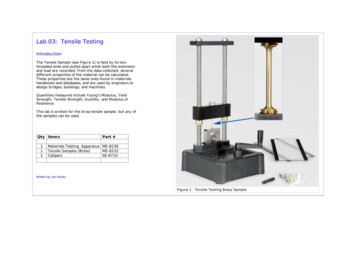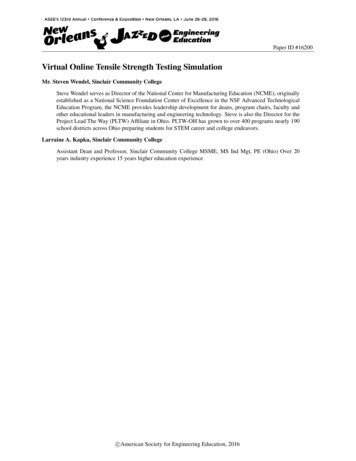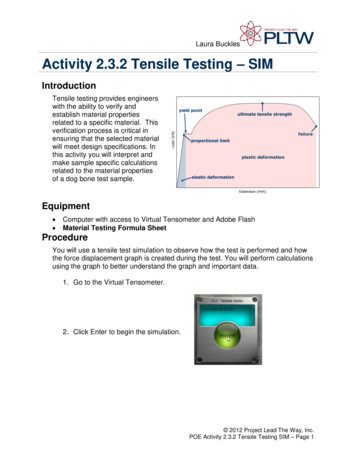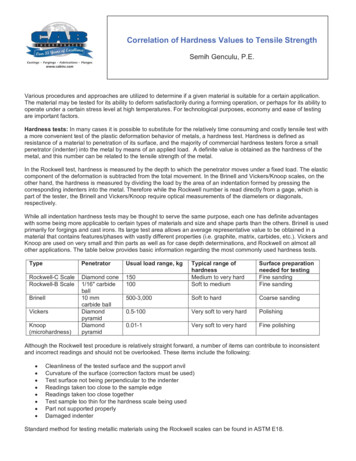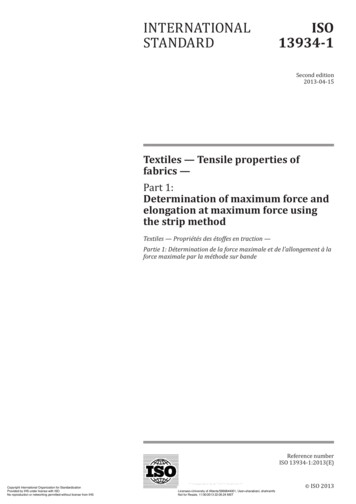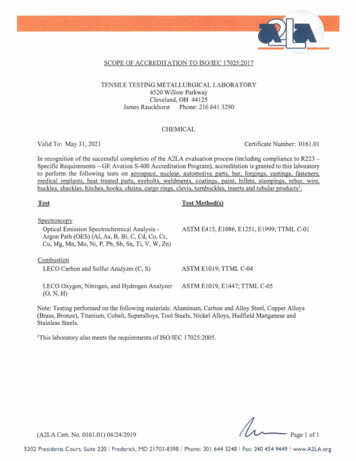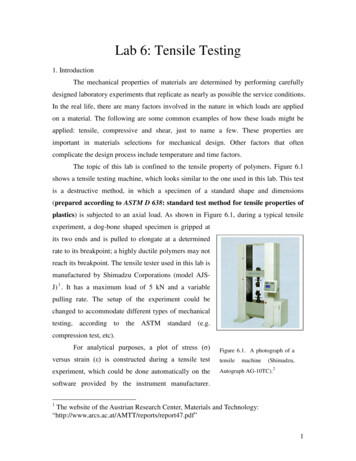
Transcription
Lab 6: Tensile Testing1. IntroductionThe mechanical properties of materials are determined by performing carefullydesigned laboratory experiments that replicate as nearly as possible the service conditions.In the real life, there are many factors involved in the nature in which loads are appliedon a material. The following are some common examples of how these loads might beapplied: tensile, compressive and shear, just to name a few. These properties areimportant in materials selections for mechanical design. Other factors that oftencomplicate the design process include temperature and time factors.The topic of this lab is confined to the tensile property of polymers. Figure 6.1shows a tensile testing machine, which looks similar to the one used in this lab. This testis a destructive method, in which a specimen of a standard shape and dimensions(prepared according to ASTM D 638: standard test method for tensile properties ofplastics) is subjected to an axial load. As shown in Figure 6.1, during a typical tensileexperiment, a dog-bone shaped specimen is gripped atits two ends and is pulled to elongate at a determinedrate to its breakpoint; a highly ductile polymers may notreach its breakpoint. The tensile tester used in this lab ismanufactured by Shimadzu Corporations (model AJSJ) 1 . It has a maximum load of 5 kN and a variablepulling rate. The setup of the experiment could bechanged to accommodate different types of mechanicaltesting, according to the ASTM standard (e.g.compression test, etc).For analytical purposes, a plot of stress (σ)Figure 6.1. A photograph of aversus strain (ε) is constructed during a tensile testtensileexperiment, which could be done automatically on theAutograph AG-10TC).machine(Shimadzu,2software provided by the instrument manufacturer.1The website of the Austrian Research Center, Materials and eport47.pdf”1
Stress, in metric system, is usually measured in N/m2 or Pa, such that 1 N/m2 1 Pa.From the experiment, the value of stress is calculated by dividing the amount of force (F)applied by the machine in the axial direction by its cross-sectional area (A), which ismeasured prior to running the experiment. Mathematically, it is expressed in Equation 6.1.The strain values, which have no units, can be calculated using Equation 6.2. In theequation, L is the instantaneous length of the specimen and L0 is the initial length.σ FA(Equation 6.1)ε L L0L0(Equation 6.2)A typical stress-strain curve would look like Figure 6.2. The stress-strain curveshown in Figure 6.2 is an example of a “text-book” stress-strain curve. In reality, not allstress-strain curves perfectly resemble the one shown in Figure 6.2. This stress-straincurve is typical for ductile metallic elements. Another thing to take note is that Figure 6.2shows an “engineering stress-strain” curve. Once a material reaches its ultimate stressstrength of the stress-strain curve, its cross-sectional area would reduce dramatically, aterm known as necking.Whenthecomputersoftware plots the stressstrain curve, it assumes thatthe cross sectional areastays constant throughoutthe experiment, even duringnecking, therefore causingthe curve to slope down.The“real”stress-straincurve could be constructeddirectly by installing a “gauge,” which measures the change in the cross sectional area ofthe specimen throughoutthe experiment.Theoretically, evenFigure 6.2. Various regions and points on the stress-straincurve.32
without measuring the cross-sectional area of the specimen during the tensile experiment,the “true” stress-strain curve could still be constructed by assuming that the volume of thematerial stays the same. Using this concept, both the true stress (σT) and the true strain(εT) could be calculated using Equation 3 and Equation 4 respectively. The derivation ofthese equations is beyond the scope of this lab report. Consult any standard mechanicstextbook to learn more about these equations. In these equations, L0 refers to the initiallength of the specimen, L refers to the instantaneous length and σ refers to theinstantaneous stress.σT σLL0(Equation 6.3) L L0 (Equation 6.4)ε T ln Figure 6.2 also shows that a stress-strain curve is divided into four regions, whichare as follows: elastic, yielding, strain hardening (commonly occurs in metallic materials)and necking. The area under the curve represents the amount of energy needed toaccomplish each of the “events.” The total area under the curve (up to the point offracture) is also known as the modulus of toughness. This represents the amount ofenergy needed to break the sample, which could be compared to the impact energy of thesample, determined using Impact test. The area under the linear region of the curve isknown as the modulus of resilience. This represents the minimum amount of energyneeded to deform the sample.The linear region of the curve of Figure 6.2, which is called the elastic region(past this region, is called the plastic region), is the region where a material behaveselastically. The material will return to its original shape when a force is released while thematerial is in its elastic region. The slope of the curve, which could be calculated usingEquation 6.5 is a constant, and is an intrinsic property of a material, is known as theelastic modulus, E. In metric unit, it is usually expressed in Pascal (Pa).E σε(Equation 6.5)3
Figure 6.3(a) shows the typical stress-strain curves of polymers. 2 The figureshows that materials that are hard and brittle do not deform very much before breaking. Ithas a very steep modulus of elasticity and a short stress-strain curve.The mechanical property of polymers generally depends on their degree ofcrystallinity, molecular weights and glass transition temperature, Tg. Highly crystallinepolymeric materials with a Tg above the room temperature are usually brittle, and viceversa. When a semi-crystalline polymer undergoes a tensile test, the amorphous chains,will become aligned. This is usually evident for transparent and translucent materials,which become opaque upon turning crystalline. Fibers are often added to polymers, aterm known as composite materials, to improve its mechanical properties. In addition toproviding extra strength to a polymer, fibers help prevent crack propagation. Moreover,the presence of the fibers prevent the amorphous portion of the polymer chains from(a)(b)aligning themselves when subjected to a tensile force, therefore, in most cases makingthem brittle. Figure 6.3 (b) shows a diagram showing the mechanical property of somecommon polymers. 3Figure 6.3. (a) A plot of stress-strain curves of typical polymeric materials. (b) A summary diagram ofthe properties of common polymers.32. Experimental ProcedureImportant!!2A website of “An Introduction to Stress-Strain Curve”:“http://www.shodor.org/ zbrewer/weave2/tutorial/node4.html”3A website of “An Introduction to Polymer ack/l tensil.html”4
Make sure you wear protecting glasses before starting any operation. Your eyescould be hurt by a broken piece of polymer.2.1 Specimen Preparation(1). The polymer specimens are dog-bone shaped. They were injection molded, and itsdimensions were determined according to the ASTMD 638, mentioned earlier in theintroduction.(2). Measure the thickness, width and gage length of polymer samples using a pairvernier calipers. These dimensions should be approximately the same for each sample.(Note: HDPE, LDPE, GFPP, and nylon will be used in the Lab)2.2 TRAPEZIUM2 Software setting(1). Go to desktop and double click on the “TRAPEZIUM2” icon. A “Login” windowwill appear. Go to the “Login” box and type user in “Username” box, and then typeuser in the “Password” box.(2). The main window will be displayed on the computer screen (Figure 6.4).Figure 6.4. Main Window of TRAPEZIUM2 Software.(3). Click on “New” icon () that is located on the top-left side of the mainwindow. The “Test Wizard” window will be displayed (Figure 6.5)).5
Figure 6.5. Test Wizard Window of TRAPEZIUM2 Software.(4). Go to the “Test Wizard” window and click on the “Method data” option of the testwizard toolbar (located on the left hand side of the test wizard window). The methoddata window will appear. Select on the appropriate testing method, determined by yourinstructor.(Note: Ask your instructor for the appropriate testing method (slow, medium orfast pulling rate), since every polymer samples have different testing conditions.)(5). In order for the computer to calculate the stress applied on the sample, the crosssectional dimension of the specimen must be entered into the software. To do so, clickon the “Specimen” option of the test wizard toolbar. Then, enter the measured widthand thickness of the specimen (this step is optional for automatic stress-strain curvegeneration).2.3 Instrumental Setting(1). Go to the tensile testing instrument. Press on the “Return” button on the digitalcontroller for a few seconds until a beeping sound is heard. The sample grips (both thetop and bottom grips) will be returned automatically to its starting position.6
(2). Place the polymer sample at the bottom grip. While still holding it vertically with onehand, use another hand to turn its handle in the closing direction as tightly as possible.(Note: The specimen should be gripped such that the two ends of thespecimen are covered by the grip, approximately 3 mm away from its gage-length. Itis important that the specimens are tightly gripped onto the specimen grips toprevent slipping, which will otherwise result in experimental errors. The “Open” and“Close” direction of the handle is noted on the grip.)(3). Use the “Up” or/and “Down” buttons, which are located next to the “Return” buttonto adjust the position of the upper grip.(Note: Make sure that the specimen is vertically aligned, if not a torsionalforce, rather than axial force, will result).(4). Turn the upper handle to “close” direction as tightly as possible. Visually verify if thesample is gripped symmetrically (equidistant) at its two ends.2.4 Starting Tensile Test(1). Go to the computer. At the top of the main window, right click on the mouse whileplacing the mouse cursor on the “Force” button (located at the top of the main window),and select “zero” option. Wait for the machine toreturn the force to zero. This will be indicated bya beeping sound.(2). Similarly, place the mouse cursor on the“Stroke” button, which is next to the “Force”button and right click to select the “zero” option.Again, wait for a few seconds to let the computerreturn its value to zero.(3). Click on the “Start” icon () that islocated at the top of the main window. The “Start Testing” window will appear (Figure6.6).(4). Click on the “Begin Test” button, found on the Start Testing window. Both the upperand bottom grips will start moving in opposite directions according to the specifiedFigure 6.6. A picture of the “ StartTesting” window7
pulling rate. Observe the experiment at a safe distance (about 1.5 meters away), at anangle and take note of the failure mode when the specimen fails.(Note: Be sure to wear safety glasses. Do not come close to equipment when thetensile test is running).(5). A plot of Force (kN) versus Stroke (mm) will be generated in real-time during theexperiment.2.5 Finishing(1). The machine will stop automatically when the sample is broken. Click the icon“Export” and type a file name in the box (*.TXT).(2). Turn the two handles to their “OPEN” direction one at a time to remove the sample.(3). Press the “Return” button on the digital controller. Both the upper and lower gripswill be returned to their original positions automatically.(4). Repeat step 4 of section 2.2 of the procedure to run more samples. Otherwise, letyour teaching assistant to print out each of the graphs obtained in the experiments as wellas the file of the generated force and stroke table.(5). Clean up any broken fragments from the specimens.3. AssignmentsDo the following for each of the polymer sample:3.1 Construct the true stress-strain curve (hint: use the equations (3) and (4) provided inthe Introduction section).3.2 Calculate the Young’s Modulus for each curve and compare with the literature values.3.3 Analyze the fracture modes of each sample (ductile fracture, brittle fracture, orintermediate fracture mode).8
reach its breakpoint. The tensile tester used in this lab is manufactured by Shimadzu Corporations (model - AJS J) 1. It has a maximum load of 5 kN and a variable pulling rate. The setup of the experiment could be changed to accommodate different types of mechanical testing, according to the ASTM standard (e.g. compression test, etc).File Size: 219KBPage Count: 8
